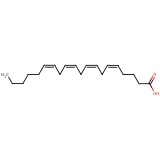| Compound Information | SONAR Target prediction | | Name: | ARACHIDONIC ACID | | Unique Identifier: | SPE01504138 | | MolClass: | Checkout models in ver1.5 and ver1.0 | | Molecular Formula: | | | Molecular Weight: | 272.213 g/mol | | X log p: | 15.756 (online calculus) | | Lipinksi Failures | 2 | | TPSA | 17.07 | | Hydrogen Bond Donor Count: | 0 | | Hydrogen Bond Acceptors Count: | 2 | | Rotatable Bond Count: | 14 | | Canonical Smiles: | CCCCCC=CCC=CCC=CCC=CCCCC(O)=O | | Source: | widespread in animal tissue | | Therapeutics: | prostaglandin & leucotriene precursor, stimulates NO biosynthesis | | Generic_name: | ARACHIDONIC ACID | | Chemical_iupac_name: | ARACHIDONIC ACID | | Drug_type: | Experimental | | Kegg_compound_id: | C00219 | | Drugbank_id: | EXPT00409 | | Logp: | 4.881 | | Cas_registry_number: | 506-32-1 | | Drug_category: | Prostaglandin H2 Synthase-1 inhibitor | | Organisms_affected: | -1 |
| Species: |
4932 |
| Condition: |
SSE1 |
| Replicates: |
2 |
| Raw OD Value: r im |
0.4258±0.0136472 |
| Normalized OD Score: sc h |
0.9306±0.00832866 |
| Z-Score: |
-1.8807±0.342166 |
| p-Value: |
0.0675206 |
| Z-Factor: |
-1.9968 |
| Fitness Defect: |
2.6953 |
| Bioactivity Statement: |
Nonactive |
| Experimental Conditions | | | Library: | SPECMTS3 | | Plate Number and Position: | 24|G5 | | Drug Concentration: | 50.00 nM | | OD Absorbance: | 600 nm | | Robot Temperature: | 24.10 Celcius | | Date: | 2008-05-01 YYYY-MM-DD | | Plate CH Control (+): | 0.041374999999999995±0.00082 | | Plate DMSO Control (-): | 0.427875±0.01969 | | Plate Z-Factor: | 0.8372 |
|  png png
ps
pdf |
| 231 |
icosa-5,8,11,14-tetraenoic acid |
| 444899 |
(5E,8E,11E,14E)-icosa-5,8,11,14-tetraenoic acid |
| 445084 |
(5E,11E,14E)-icosa-5,11,14-trienoic acid |
| 3037205 |
(5Z,8Z,11Z,14Z)-5,6,8,9,11,12,14,15-octatritioicosa-5,8,11,14-tetraenoic acid |
| 3246804 |
(5Z,8Z,11Z,14Z)-5,6,8,9,11,12,14,15-octadeuterioicosa-5,8,11,14-tetraenoic acid |
| 5312408 |
(5E,8E)-tetradeca-5,8-dienoic acid |
| internal high similarity DBLink | Rows returned: 1 | |
| active | Cluster 8909 | Additional Members: 3 | Rows returned: 0 | |
|
